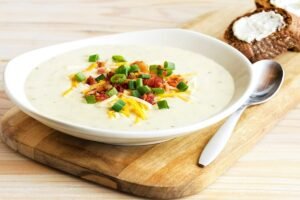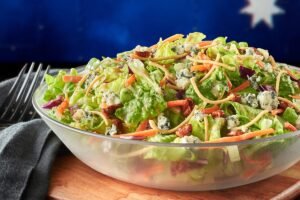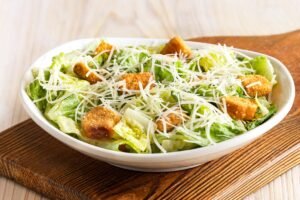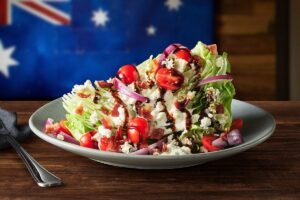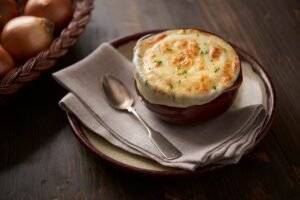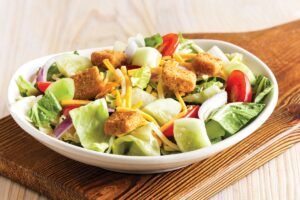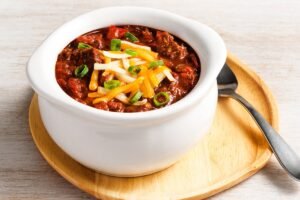Soups and side salads at Outback serve as the opening act for many meals, but they’re far from throwaway items. These smaller portions set the tone for the dining experience, offering a glimpse of the kitchen’s capabilities before the main event arrives. Whether you’re warming up with a bowl of French onion soup or keeping things light with a house salad, these starters have developed their own devoted following.
The soup and salad additions came to Outback gradually, responding to customer requests for lighter beginnings to heavy steak dinners. What started as three basic options has evolved into a rotating selection that changes seasonally while maintaining core favorites that customers would riot without.
The French Onion Soup Excellence
Outback’s French onion soup deserves special recognition for achieving what many restaurants fail at – proper caramelization without burnt edges, broth that tastes like beef rather than salt water, and cheese that stretches rather than globs. The process starts the day before service with onion preparation.
Yellow onions get sliced to exactly 1/4 inch thickness using mandoline slicers. Thicker slices won’t caramelize evenly; thinner ones disappear into mush. Each batch uses 10 pounds of onions that reduce to about 3 pounds after caramelization. The cooking happens in stages – first sweating at low heat for 20 minutes, then medium heat for 25 minutes with frequent stirring, finally deglazing with sherry that adds subtle sweetness.
The beef broth simmers for 8 hours using real bones, not base or bouillon. This long extraction creates gelatin that gives the soup body without flour thickening. The final assembly involves ladling hot soup into oven-safe crocks, floating baguette slices that have been toasted on both sides, then covering with a specific cheese blend – 60% provolone for stretch, 40% Swiss for flavor.
The broiling requires attention – 45 seconds too long and cheese burns, 30 seconds short and it doesn’t properly bubble. Each crock gets positioned exactly 4 inches from the broiler element. The result should show golden-brown spots across bubbling cheese that stretches from crock to spoon when lifted.
Soup Rotation and Seasonal Strategy
While French onion and baked potato soup remain permanent fixtures, the rotating soup selections follow careful planning based on weather patterns, regional preferences, and ingredient availability. The soup calendar gets planned quarterly, with flexibility for adjustments based on unexpected weather changes.
Cold weather months feature heartier options like beef and barley, loaded potato variations, and chili. Summer brings lighter choices like gazpacho in Southwest locations, corn chowder during peak season, and cold cucumber soup in test markets. The transitions happen gradually – spring might feature both winter and summer options during the same week.
Regional differences significantly impact soup offerings. New England locations feature clam chowder daily, while it appears only on Fridays elsewhere. Texas restaurants offer tortilla soup year-round. California locations include more vegetarian options like roasted red pepper or butternut squash.
Each soup recipe undergoes development at corporate test kitchens before regional rollout. The testing process involves not just taste but operational feasibility – can busy kitchens execute it consistently? Does it hold well during service? What’s the waste factor if it doesn’t sell?
Side Salad Composition and Standards
Side salads might seem simple, but Outback maintains specific standards that elevate them beyond typical restaurant offerings. The house salad uses five types of greens, creating texture variety in a small portion. Tomatoes get cut into wedges rather than diced, maintaining structural integrity and preventing water release that makes salads soggy.
Cucumber slicing happens at precise 1/8 inch thickness – thick enough to provide crunch but thin enough for easy eating. Red onions soak in cold water for 30 minutes before use, removing harsh bite while maintaining flavor. Croutons get made fresh daily from yesterday’s bread, tossed with garlic butter and herbs before toasting.
The assembly follows specific patterns ensuring even distribution. Greens form the base, then harder vegetables arrange around the perimeter, tomatoes position at compass points, and croutons sprinkle across the top. This systematic approach means every forkful contains all components rather than leaving diners with just lettuce at the bottom.
Dressing portions for side salads measure exactly 1.5 ounces, calibrated through extensive testing to coat without drowning. Servers learn to offer fresh-ground pepper and extra dressing proactively, as these requests come frequently enough to justify anticipation.
The Blue Cheese Wedge Phenomenon
The wedge salad represents a fascinating paradox – it’s simultaneously the simplest and most controversial salad on the menu. Critics dismiss it as lazy (it’s literally a quarter head of lettuce), while devotees insist it’s the perfect salad. Outback’s version succeeds through quality ingredients and precise execution.
The iceberg lettuce selection process eliminates heads that are too loose (won’t hold together when cut) or too tight (bitter flavor). Each head gets cored and quartered with a single decisive cut – multiple cuts create ragged edges that look unprofessional. The quarters immediately go into ice water for 10 minutes, crisping the leaves while removing any bitterness.
Blue cheese dressing gets applied generously but strategically. Rather than dumping it on top, servers drizzle in a crosshatch pattern that allows dressing to seep between leaves. Bacon arrives hot from the kitchen, not from a warming tray, creating temperature contrast. The tomatoes and onions get scattered rather than piled, ensuring each bite has variety.
The knife service adds psychological value – cutting your own salad feels interactive and substantial. The wedge’s stability allows aggressive cutting without chasing lettuce around the plate, a frustration with chopped salads.
Temperature and Timing Coordination
Soups and salads arrive at tables within 5-7 minutes of ordering, requiring careful coordination between cold and hot stations. Soups maintain holding temperature at 165°F in specialized equipment that prevents scorching while ensuring food safety. Each soup gets stirred every 30 minutes to prevent skin formation and ensure even heating.
Salads require opposite treatment – components stay refrigerated until order moment. The assembly happens in a refrigerated rail that maintains 38°F, preventing wilting during busy periods. Plates get chilled before plating, adding precious minutes of crispness during table delivery.
The timing challenge intensifies when tables order both soup and salad. Kitchen protocols dictate salads get made first, then held in refrigeration while soup portions get ladled and garnished. This sequencing prevents salads from wilting under heat lamps while ensuring soups arrive properly hot.
Sharing Dynamics and Portion Psychology
Side salads and soups occupy interesting portion territory – technically individual servings but often shared between couples or friends. Outback accommodates this behavior with subtle adjustments. Servers automatically bring extra plates when one salad gets ordered for a two-person table.
The “soup and salad” combination, while not officially promoted, gets accommodated through half-portions at many locations. A cup of soup with a side salad creates a light meal for around $10, competing effectively with fast-casual lunch options.
Bread service timing coordinates with soup and salad delivery. The warm bread arrives simultaneously, allowing diners to dip in soup or clean dressing from salad plates. This orchestration requires communication between servers and kitchen, as bread must be fresh from the oven, not reheated.
Ingredient Quality and Sourcing
Soup ingredients follow similar quality standards as entrée components. The baked potato soup uses the same potatoes as baked potato sides, maintaining flavor consistency. Bacon comes from the same supplier as burger toppings, ensuring uniform quality. This ingredient overlap reduces inventory complexity while maintaining standards.
Produce for side salads arrives three times weekly from regional distributors. Unlike some chains that use pre-cut lettuce, Outback processes greens in-house, extending freshness and allowing quality control. Brown edges, wilted leaves, or off-colors get removed during prep, ensuring only prime portions reach plates.
Seasonal ingredients like strawberries undergo careful sourcing. Rather than using year-round greenhouse berries, Outback follows growing seasons, featuring strawberry salads only when quality meets standards. This seasonal discipline maintains integrity even when customers request items out of season.
Maximizing the Experience
Order soup and salad strategically. If sharing, the wedge salad provides best value and presentation. For solo dining, house salad with soup creates a satisfying light meal. The French onion soup works best as a shared starter due to richness.
Don’t overlook seasonal options – they exist because ingredients are at peak quality. The strawberry salad in June tastes noticeably better than forcing it in December. Similarly, heartier soups satisfy more in cold weather when bodies crave warming foods.
Consider these items for takeout carefully. Salads travel poorly unless dressing stays separate. Soups maintain temperature well in proper containers. The French onion soup doesn’t travel due to cheese solidifying, losing the stretchy appeal that makes it special.
The Verdict
Soups and side salads at Outback prove that supporting players deserve respect. Through quality ingredients, proper technique, and attention to detail, these smaller portions deliver satisfaction that belies their menu position. They’re not just obligatory additions but legitimate reasons to visit.
Whether starting a meal, creating a light lunch, or adding variety to heavy entrées, these options fulfill their roles admirably. They demonstrate Outback’s commitment to executing every menu item with care, regardless of price point or portion size.
The next time you’re tempted to skip straight to entrées, reconsider. These soups and salads might surprise you with their quality and satisfaction. Sometimes the best part of a steakhouse meal comes before the steak ever arrives.
